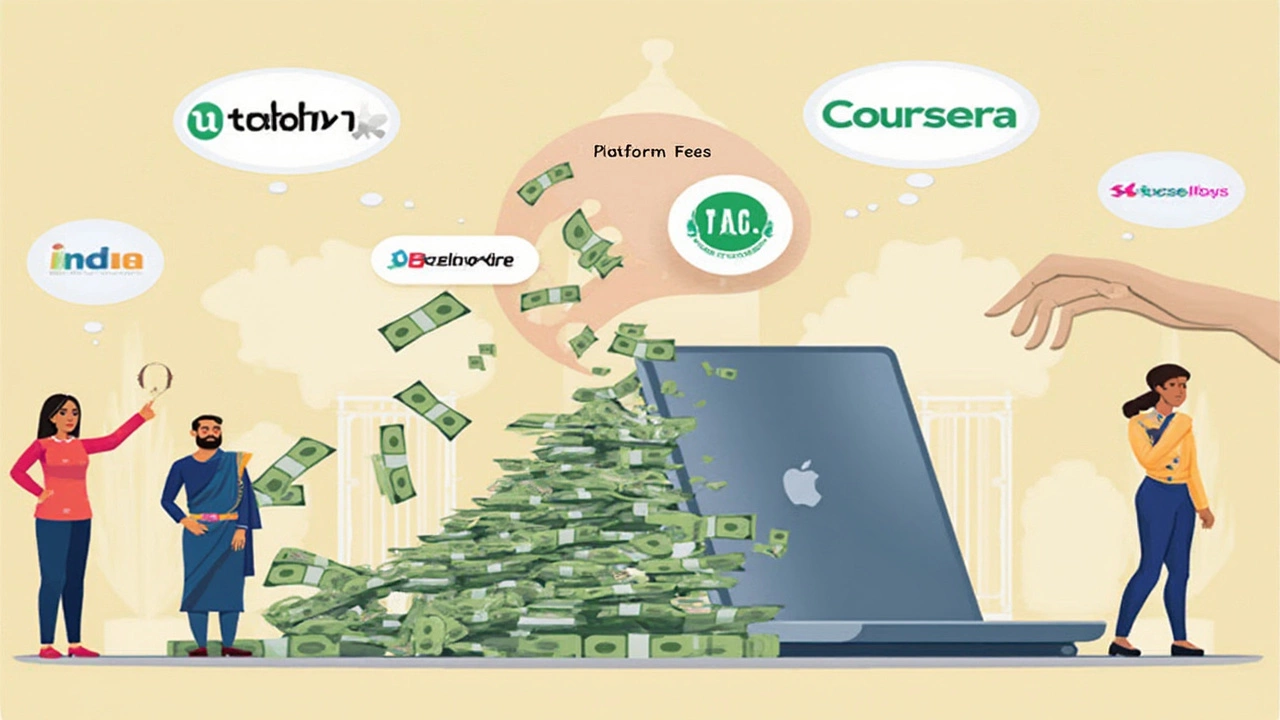People often guess sites like Udemy or Coursera pay the most, but the real story is a bit messier. Sure, those platforms are huge, but size doesn't always mean bigger paychecks for instructors. Some less mainstream platforms quietly offer far better revenue splits and bonuses—if you know where to look.
Before you jump into filming your first course, it pays to know how each platform actually pays teachers. Some give you a fat chunk of every sale if students find your course on their own. Others suck up most of the profit and hand you a tiny commission, even if you bring them hundreds of paying learners. There are sneaky pitfalls like transaction fees and payout minimums, too.
- Biggest Platforms by Payouts
- How Instructors Really Get Paid
- Hottest Course Topics for Top Earnings
- Hidden Costs No One Tells You About
- Insider Tips to Maximize Your Income
Biggest Platforms by Payouts
If you're hunting for the highest paying e-learning platforms, you might be surprised. The leaders on sheer size—like Udemy and Coursera—don’t always dish out the biggest checks to instructors.
Udemy has the largest course catalog out there and pays instructors 37% to 97% per sale, depending on how the student found your course. You get the high end only if the student buys directly through your link. If Udemy brings the buyer, expect way less. Practical example? If your course sells for $100, you keep $37 to $97. But, here's the catch—the average sale price with constant discounts hovers around $11.
Coursera, on the other hand, works a bit differently. Many courses here are produced in partnership with universities or brands. If you’re an individual instructor, it’s pretty hard to get in. And profit splits can get complicated, with some creators getting paid per enrollment and others via a flat fee negotiated in advance.
| Platform | Typical Instructor Cut | Access Requirements |
|---|---|---|
| Udemy | 37% - 97% per sale | Low - Anyone can join |
| Coursera | Varies; often fixed deals | High - Often institutions only |
| Skillshare | Royalties based on minutes watched | Low - Anyone can publish |
| Teachable | 90%+ (direct sales) | Low - Anyone, must do own marketing |
Skillshare is a bit different. Instead of getting paid per enrollment, you earn royalties based on how many minutes people watch your content out of all content watched on the platform that month. In 2024, Skillshare said its top teachers made up to $2,000 a month, but most make far less.
Teachable isn’t really a marketplace at all—you build your own school, set your own prices, and can keep over 90% of each sale after small processing fees. The upside? No one takes a giant slice of your profits. The downside? You bring your own students, so marketing is on you.
"The biggest payouts don't always come from the biggest brands. Instructors who control their own audience typically earn two to five times more than those who rely on platform traffic alone." – EduGrowth Report, Q1 2024
Bottom line: Platforms with the most users don’t always mean the biggest money. If you’re ready to hustle on marketing, sites like Teachable or Thinkific let you keep nearly all sales, while Udemy and Skillshare offer exposure but take a bigger bite.
How Instructors Really Get Paid
The way you earn money as an instructor on e-learning platforms is anything but straightforward. Some sites make it look like you’ll get a fat slice of every student payment, but the real math is usually hidden in the fine print. Let’s dig into the most popular payout models so you know what you’re really signing up for.
Most platforms use one (or a mix) of these:
- Revenue Share Model: Here, the platform takes a big chunk—for example, Udemy gives instructors 37% to 97% of the course price, depending on how the student finds your course. If the sale comes straight from your own promotion, you keep more. But if the platform sells your course for a heavy discount or promotions, your share can shrink fast.
- Subscription Pools: Think Skillshare. Students pay a monthly fee and the site splits revenue based on how many minutes people spend watching your courses. More watch time, more cash. But competition is tough—only the popular teachers see real cash build up.
- Flat Payments / Contracts: Coursera or LinkedIn Learning might actually hire you to create a course and pay upfront or per milestone. This pays well but is invite-only and often means you surrender all rights to future sales.
Here's a snapshot of how top online teaching platforms handle instructor pay:
| Platform | Typical Payout Range | Pay Frequency |
|---|---|---|
| Udemy | 37%–97% per sale | Monthly |
| Skillshare | Based on watch time (avg $0.07–$0.10/min) | Monthly |
| Coursera | Flat contract or royalties (varies) | Quarterly |
| Teachable | 80%–95% (minus fees) | Monthly |
Even though course platforms lure you in with big numbers, fees can sting. Watch for payment processor fees, taxes, and sometimes minimum payout thresholds. For a good chunk of instructors, these hidden costs really eat into earnings, making that flashy headline number less exciting in your actual bank account.
If you want the highest-paying e-learning platform, always ask yourself: Where will my students really come from? If you have your own audience, you can pocket a lot more by hosting on sites like Teachable or Thinkific that don’t take so much off the top. If you’re hoping to ride the platform’s marketing, expect to share a lot more of your hard-earned money.

Hottest Course Topics for Top Earnings
Looking for a sweet spot where passion meets paycheck? Some e-learning platforms practically print money for instructors who pick the right topics. Not all subjects pay the same—people still pay more for hard skills that boost paychecks, help change careers, or solve stressful problems.
Here’s a breakdown of the subjects that have been crushing it in the last year on highest paying platforms:
- Tech Skills: Think Python, machine learning, data analysis, and full-stack web development. These aren’t just buzzwords—courses in these areas regularly make double or triple what more general courses pull in. Cloud certifications (AWS, Azure, Google Cloud) are especially hot, because companies scramble to find qualified people.
- Business and Finance: Advanced Excel, project management, accounting, and investing essentials are top searches. There’s huge demand for real-world money skills and anything that helps you get a promotion or a raise.
- Personal Development: This one flies under the radar, but courses on productivity hacks, stress management, and public speaking do surprisingly well. The trick is to sell transformation, not just knowledge.
- Design and Marketing: Adobe Creative Suite, UX/UI, social media strategy, and content creation attract a creative crowd who’s hungry to level up.
- Test Prep and Certification: If you’ve got experience helping people pass exams like PMP, IELTS, GRE, or CompTIA, you can charge a premium for your expertise.
Here’s a quick peek at what instructors made on different online teaching topics according to a 2024 Thinkific and Teachable survey:
| Course Topic | Average Monthly Earnings (US$) |
|---|---|
| Cloud Computing (AWS/Azure) | 2,500 |
| Data Science & AI | 2,200 |
| Investing & Personal Finance | 1,900 |
| Digital Marketing | 1,700 |
| Soft Skills (Communication, Management) | 1,100 |
If you’re debating between a few ideas, check the trending topics section on big sites like Udemy, LinkedIn Learning, or Skillshare. More often than not, the highest paying courses are ones that solve expensive problems, not just deliver trivia. Look at top-rated competitors, then figure out exactly where you can offer something fresher or more hands-on.
And here’s a quick reality check: just uploading a course on any of these topics doesn’t mean you’ll automatically make bank. Students are picky—they care about course reviews, how deep you go, and how up-to-date your info is. The big money comes to instructors who don’t just teach, but help people get usable results.
Hidden Costs No One Tells You About
It’s easy to get excited about those big earnings numbers flashed on e-learning sites. But there are sneaky costs that can quietly eat away at your income, and very few instructors realize their first payout will probably look a lot smaller than expected. The real problem? Not all platforms are up front about these details.
On big e-learning platforms like Udemy, Skillshare, and Coursera, typical hidden costs include:
- Marketing fees: Platforms take a chunky percentage—sometimes up to 75%—if a course is sold in a big sitewide promotion instead of through your own referral link.
- Transaction fees: Payment processors and banks grab their cut. PayPal, for example, charges around 2-5% on each payout, depending on your country.
- Payout minimums: Some sites won’t release your money until you stack up $50 or even $100 in sales. Small earnings can get stuck for months.
- Refund policies: Udemy’s 30-day refund window means your sale isn’t safe for a month. High refund rates can eat into what you thought was already earned cash.
- Production costs: It’s on you to buy your own camera, microphone, and editing tools. Even basic equipment can set you back a few hundred bucks right out of the gate.
Take a look at how these fees add up on some of the most popular highest paying e-learning platforms:
| Platform | Average Platform Fee | Payout Minimum | Typical Payment Processor Fee |
|---|---|---|---|
| Udemy | 50-75% | $50 | 2-3% (PayPal) |
| Skillshare | 30-40% | $10 | 2-5% (PayPal) |
| Teachable | 0-10% (if on Pro plan) | $1 | 2-3% (Stripe/PayPal) |
If you’re thinking of joining a highest paying platform, read their payout and fee policies super carefully. And watch out for taxes—most platforms don’t deduct them, so you need to handle this yourself. Forgetting this little detail can lead to a nasty surprise come tax season.
The bottom line: Don’t just focus on what you could make. Always dig into what you’ll actually take home, after all the little deductions and requirements.

Insider Tips to Maximize Your Income
If you want to consistently earn more from e-learning platforms, just uploading a course won't cut it. Here are some solid, practical ways to actually boost your take-home pay—without working yourself into the ground.
- Pick niche topics people really need. Broad stuff like “Intro to Python” is jam-packed with competition. But if you do “Python for Retail Analytics,” you can stand out, charge more, and attract a serious crowd. The same goes for things like “Business English for Nurses” instead of just “Business English.”
- Promote your own course links. Most platforms (like Udemy and Teachable) give way better revenue if a student buys using your own link—sometimes you get up to 97%, instead of 25-50% via the site’s marketing. Share those links in your emails, blog, or YouTube channel.
- Bundle courses or offer packages. Sites like Skillshare and Thinkific let you combine smaller lessons into a premium package. People who buy these tend to stick around, which boosts those recurring earnings, especially with subscription-based platforms.
- Stay active with updates and answering questions. Courses that get quick instructor replies and new content updates rank higher and sell more. On Udemy, instructors who answer questions within 24 hours see up to 25% more enrollments, according to their 2024 teaching report.
- Try multiple online teaching platforms. Your course can live in more than one place (unless you signed an exclusivity deal—always check that section of the contract). Some instructors quietly earn double by putting their content on both Udemy and their own Thinkific site.
| Platform | Instructor Share (Own Link) | Instructor Share (Platform Sale) |
|---|---|---|
| Udemy | 97% | 37% |
| Teachable (basic) | 100% | N/A |
| Skillshare | N/A | Royalties (varies) |
| Coursera | 15-20% | 15-20% |
Don’t forget about course reviews—they make or break your sales. Politely ask students for feedback after they complete a module, or even offer a tiny bonus resource for filling out a review. The more genuine reviews, the higher your course ranks (and the more you earn).
And here's something a lot of newbies wish they knew: keep your content fresh. In fast-changing fields—like advanced Excel functions or anything AI—updating your material every six months keeps sales from tanking. Regular updates also help dodge the awkward "this is outdated" comments that scare off buyers.





